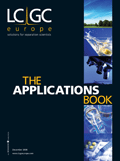LC–MS Analysis of Glyphosate and AMPA using Hypercarb Columns
The Application Notebook
Glyphosate [N-(phosphonomethyl) glycine] is a broad spectrum, non-selective herbicide, which acts by inhibiting the shikimic acid pathway in plants. Recent studies have raised global health and environmental concerns about glyphosate's use.1 Glyphosate readily breaks down into aminomethyl phosphonic acid (AMPA) in the environment; requiring accurate measurement. Both highly polar compounds present an analytical challenge to the chromatographer (Figure 1). Typical silica based reversed-phase C18 columns experience difficulty with the retention of such polar compounds, and may generate non-resolved co-eluting peaks, often with polar analytes eluting in the void volume. Traditional analytical methods require complex eluents and time consuming derivatization steps to achieve retention on a reversed-phase support.
Glyphosate [N-(phosphonomethyl) glycine] is a broad spectrum, non-selective herbicide, which acts by inhibiting the shikimic acid pathway in plants. Recent studies have raised global health and environmental concerns about glyphosate's use.1 Glyphosate readily breaks down into aminomethyl phosphonic acid (AMPA) in the environment; requiring accurate measurement. Both highly polar compounds present an analytical challenge to the chromatographer (Figure 1). Typical silica based reversed-phase C18 columns experience difficulty with the retention of such polar compounds, and may generate non-resolved co-eluting peaks, often with polar analytes eluting in the void volume. Traditional analytical methods require complex eluents and time consuming derivatization steps to achieve retention on a reversed-phase support.

Figure 1
Hypercarb is a 100% porous graphitic carbon (PGC) stationary phase and possesses a flat, highly crystalline surface. The permanent dipole of polar molecules can induce a dipole on the polarizable surface of the graphite as they approach it, increasing the interaction between the analyte and the graphite surface. This dipole–dipole interaction results in excellent retention for polar compounds. Hypercarb columns show greater retention and resolution than silica based C18 columns, without an ion pair reagent in the mobile phase.
Experimental
The analyses of glyphosate and AMPA were performed using a Finnigan LC–MS system (Thermo, San Jose, California, USA). The separations were performed using 50 × 2.1 mm columns (Thermo, Bellefonte, Pennsylvania, USA); Hypersil BDS C18 5 µm (part number 28105-052130) and Hypercarb 5 µm (part number 35005-052130) with the following conditions:
Eluent: A: H2O + 0.1% formic acid
B: ACN + 0.1% formic acid
Gradient: 5–100% B in 10 min
Flow-rate: 0.3 mL/min
Detection: MS +ESI SIM [M+H]+ (m/z 112, 170).
Results and Discussion
Figure 2 compares the separation of glyphosate and AMPA on both a silica-based C18 column (Hypersil BDS C18) and a Hypercarb column. The chromatogram on the right exhibits behaviour typical of very polar compounds in reversed-phase LC when analysed using the silica C18 column: Glyphosate and AMPA are observed to co-elute near the void volume (at 0.48 and 0.51 min respectively).

Figure 2
Conversely, Hypercarb is observed to retain and resolve AMPA and glyphosate as shown in the left hand chromatogram. This ensures that a robust quantitative method can be developed. The capacity factor for glyphosate is 2.2. Baseline resolution is readily achievable between the two compounds, allowing for maximum sensitivity when quantifying them together.
The method developed on Hypercarb uses a mobile phase containing 0.1% formic acid, which promotes protonation of the amino/NH groups and further enhances sensitivity when +ESI is used as the detection method.
Because Hypercarb is able to retain polar compounds, it can also be used for solid-phase extraction applications where its strong retention properties allow the use of low bed weights. Hypercarb solid-phase extraction formats (HyperSep Hypercarb) have proven successful for trace enrichment of polar pesticides and metabolites,2 and may provide a solution for glyphosate and AMPA applications.
Conclusion
The combination of retention, ease of method development and increased sample throughput makes Hypercarb ideal for accurate routine measurement of glyphosate and AMPA.
References
1. C. Cox, Herbicides Fact Sheet, Glyphosate (Roundup), Journal of Pesticide Reform, 18, 3–17 (1989).
2 M.C. Hennion, J. of Chromatogr. A, 885, 73–95 (2000).

Thermo Electron Corporation
112 Chadwick Road, Runcorn WA7 1PR, UK
tel. +44 1928 581 000 fax +44 1928 581 078
E-mail: enquiries@thermohypersil.co.uk
Website: www.thermo.com

University of Tasmania Researchers Explore Haloacetic Acid Determiniation in Water with capLC–MS
April 29th 2025Haloacetic acid detection has become important when analyzing drinking and swimming pool water. University of Tasmania researchers have begun applying capillary liquid chromatography as a means of detecting these substances.

.png&w=3840&q=75)

.png&w=3840&q=75)



.png&w=3840&q=75)



.png&w=3840&q=75)








